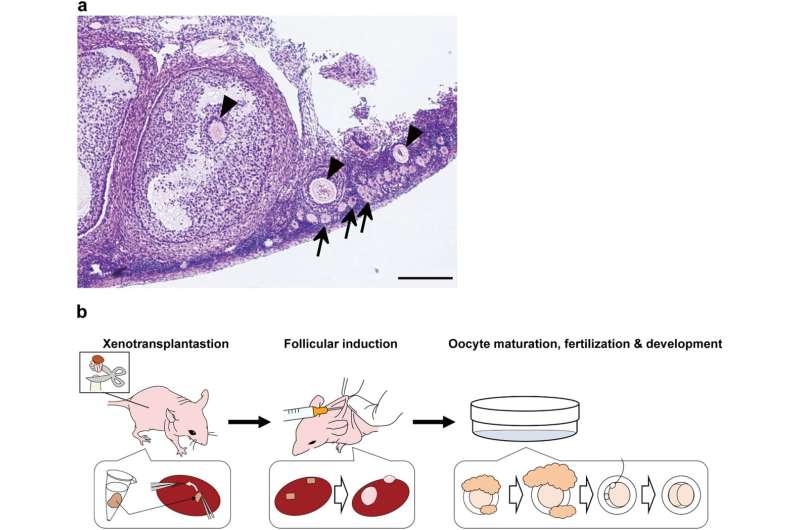This article has been reviewed according to Science X's editorial process and policies. Editors have highlighted the following attributes while ensuring the content's credibility:
fact-checked
peer-reviewed publication
proofread
Scientists develop marmoset eggs and embryos from xenotransplanted ovary tissues

Marmosets are now used in medical and pharmacological research as a model animal of non-human primates. Recently, genetically modified marmosets are also used in research to elucidate human pathology, higher brain functions, etc. However, generation of genetically modified marmosets requires a large number of eggs, and the method of harvesting eggs from female marmosets raises issues of animal welfare and costs.
Conventionally, ovaries of marmosets that have died from experiments or diseases have been discarded without usage. There are, in fact, a large number of usable oocytes remaining in these tissues. Japanese researchers at Niigata University and University of Toyama aimed to establish a low-cost marmoset egg production system in an animal welfare-friendly manner by xenotransplanting these ovaries.
These researchers developed eggs by xenotransplanting the marmoset ovaries under the renal capsule of immunodeficient mice. The eggs were then obtained and fertilized, resulting in blastocysts. These results were published in Scientific Reports on October 24, 2023.
"Ovarian xenotransplantation successfully produced blastocysts in farm animals like pigs and cows, as well as in rodents, but in marmosets only a success in developing follicles was reported. In this study, we could successfully produce eggs and obtain blastocysts, and it was very challenging to break through that difficulty," said Runa Hirayama, a graduate student at the University of Toyama.
Marmoset ovaries donated from research facilities and institutions all over Japan were used as transplantation donor and various xenotransplantation conditions were examined in detail. One of the critical conditions is the use of larger marmoset ovarian fragments for transplantation into mouse kidneys.
In addition, eggs obtained in this system require a longer culture period than those obtained from normal female marmosets for efficient fertilization. The team not only succeeded in harvesting oocytes from xenotransplanted marmoset ovaries, but also in fertilizing and developing them into blastocysts.
"This novel egg production system is expected to be a new method of supplying eggs for the generation of genetically modified marmosets and will facilitate the research of human diseases," said Dr. Hiroaki Taketsuru, at Niigata University.
The achievement of this research can be applied to the establishment of naive ES cells, and will contribute to the development of regenerative medicine.
More information: Runa Hirayama et al, Production of marmoset eggs and embryos from xenotransplanted ovary tissues, Scientific Reports (2023). DOI: 10.1038/s41598-023-45224-x



















